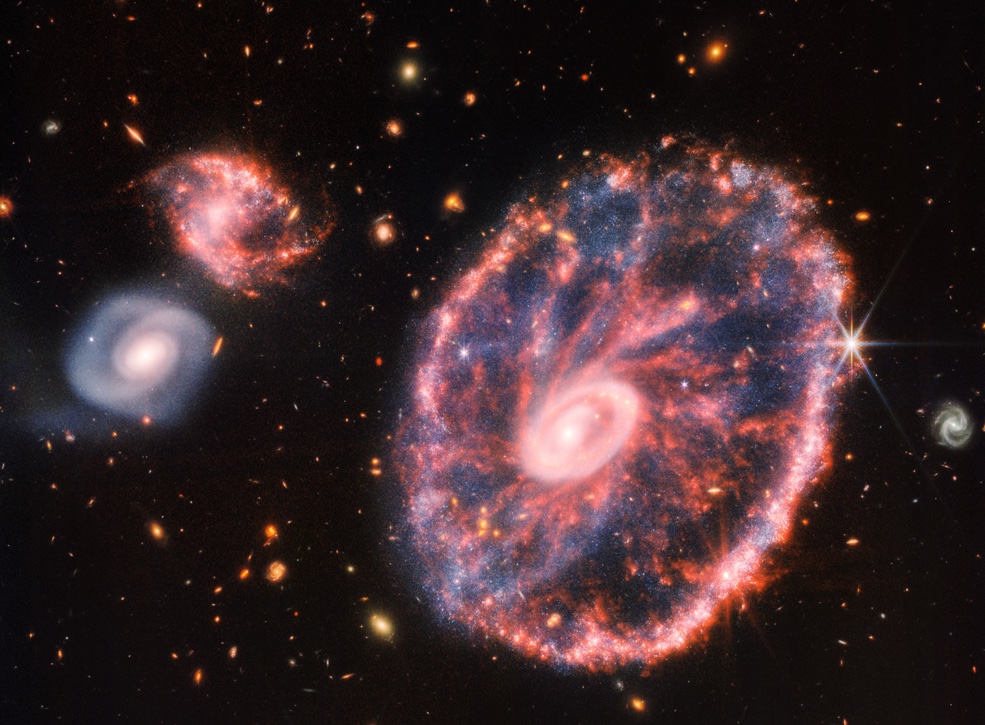

The gloriously powerful James Webb Space Telescope may well take us forward in our ongoing quest to learn more about the universe and our origins, but sometimes it’s worth simply marveling at the stunning imagery that the observatory is sending home as part of its groundbreaking mission.
Take this extraordinary view shared by NASA on Tuesday, August 2, captured by one of Webb’s powerful infrared cameras. It shows the Cartwheel Galaxy in all its breathtaking beauty, the patterns, colors, and shape a sight to behold.

Located some 500 million light-years away in the Sculptor constellation, NASA describes the Cartwheel Galaxy as a “rare sight.” It dominates the image, with two companion galaxies also visible against a backdrop of many others.
“Its appearance, much like that of the wheel of a wagon, is the result of an intense event — a high-speed collision between a large spiral galaxy and a smaller galaxy not visible in this image,” NASA says. “Collisions of galactic proportions cause a cascade of different, smaller events between the galaxies involved [and] the Cartwheel is no exception.”
In a post on its website, the space agency points out the Cartwheel Galaxy’s two rings — a bright inner ring and an outer, colorful ring. “These two rings expand outwards from the center of the collision, like ripples in a pond after a stone is tossed into it. Because of these distinctive features, astronomers call this a ‘ring galaxy,’ a structure less common than spiral galaxies like our Milky Way.”
The dazzling core holds a huge amount of hot dust, and the brightest spots indicate enormous young star clusters. The outer ring, meanwhile, has expanded for around 440 million years, and as it does so it plows into surrounding gas, leading to the formation of yet more stars.
NASA notes that existing space-based observatories such as the Hubble Space Telescope have already had the Cartwheel within its sights, but Webb, with its ability to detect infrared light, has been able to offer more detailed views of the distant galaxy.
For example, Webb’s primary imager, the Near-Infrared Camera (NIRCam), has been able to highlight even more stars than previously observed in visible light. “This is because young stars, many of which are forming in the outer ring, are less obscured by the presence of dust when observed in infrared light,” the agency explains.
Meanwhile, data from Webb’s Mid-Infrared Instrument (MIRI) appear in red in the image. The spiraling spokes that form the Cartwheel Galaxy’s skeleton are areas with an abundance of hydrocarbons and other chemical compounds, and also silicate dust. “These spokes are evident in previous Hubble observations released in 2018, but they become much more prominent in this Webb image,” NASA says.
Webb’s observations confirm that while the Cartwheel was probably similar in appearance to the Milky Way before its collision, it is now in what NASA describes as “a very transitory stage.”
Following its launch in December 2021, the James Webb Space Telescope is now in an orbit about a million miles from Earth. Last month NASA shared the first set of high-resolution, color images from what is the most powerful space observatory ever built. And just like this one of the Cartwheel Galaxy, they didn’t disappoint.
Digital Trend, New tech, tech news, wikiHow

No comments:
Post a Comment